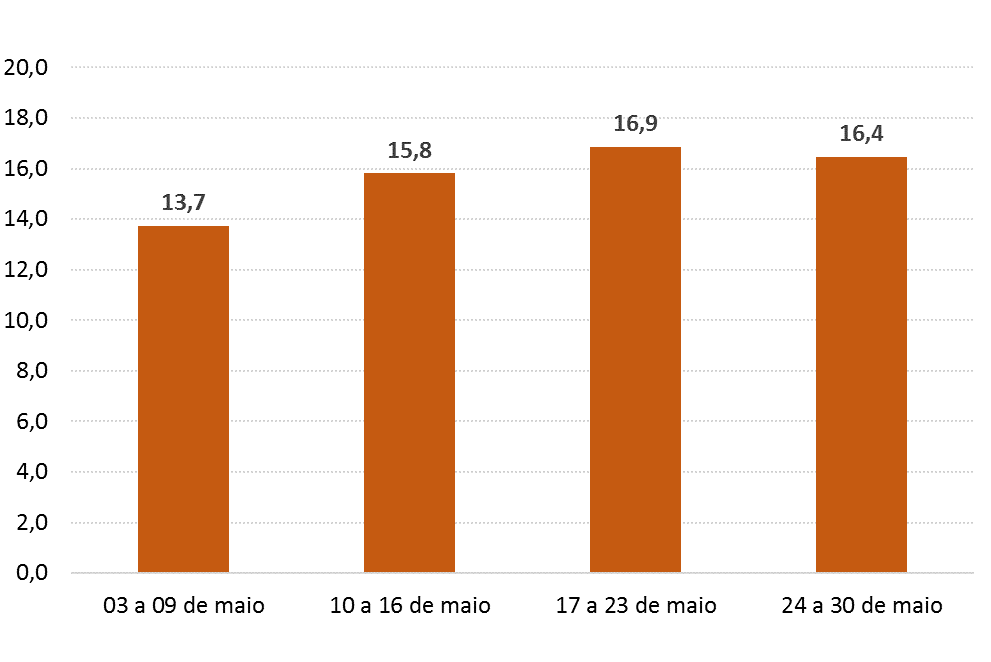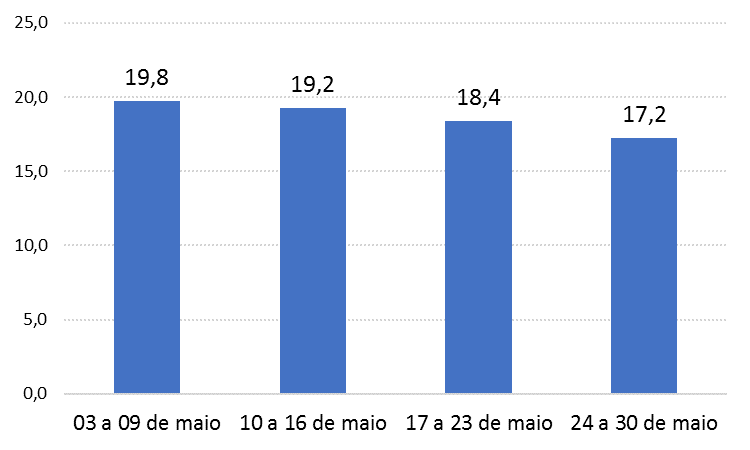3.6 million persons with symptoms associated with flu syndrome sought some health establishment in the week between May 24 and 30
June 16, 2020 02h00 PM | Last Updated: June 17, 2020 04h57 PM
In the week between May 24 and 30, 2020, the IBGE´s PNAD COVID19 estimated that 22.1 million persons (or 10.5% of the population) showed at least one of the 12 symptoms associated with the flu syndrome (fever, cough, sore throat, difficulty to breathe, headache, chest pain, nausea, runny or stuffy nose, fatigue, eye pain, loss of smell or taste and muscle pain) that are investigated by the survey. This contingent remained statistically stable against the previous week (22.7 million or 10.8% of the population), though it fell compared with the weeks of May 10-16 (24.7 million or 11.7%) and of May 3-9 (26.8 million or 12.7%).
Nearly 16.4% of those who had symptoms (or 3.6 million persons) sought attendance in health establishments (health centers, family health teams, Emergency Care Units, SUS Medical Centers or Hospitals, as well as private ambulatories/offices, medical centers or hospitals). This contingent remained statistically stable in relation to the previous week (3.8 million or 16.9%), and also against the weeks of May 10-16 (3.9 million or 15.8%) and of May 3-9 (3.7 million or 13.7%). More than 80% of these attendances were in the public health network.
Nearly 1.1 million persons sought attendance in hospitals, either public or private, in the week of May 24-30. Among them, 127 thousand (11.7%) were hospitalized.
Among the persons who showed symptoms, but did not go to any health establishment, 82.4% decided to stay at home and 58.6% bought or took medicines on their own. Only 4.8% called a health professional and 13.3% bought or took medicines with medical orientation.
PNAD COVID19 estimated the employed population in Brazil in the week of May 24-30 at 84.4 million. Among them, 8.8 million (or 13.2% of the employed persons) worked remotely and 14.6 million (17.2%) left their work due to social distancing.
In the same period, the population out of the workforce – which was not working nor searching for work – was 74.6 million, from which 25.7 million (or 34.4%) stated that they would like to work. That proportion remained statistically stable along the four weeks under analysis. In addition, a significant part (68.9% or 17.7 million) of the persons out of the workforce who did not look for a job, refused to do it because of the pandemic or for not finding an employment in the locality where they lived.
Percentage of persons with any symptom of the flu syndrome who sought a health establishment - Brazil

Between the first and the fourth week of the month, of the 12 symptoms surveyed by PNAD COVID19, almost all of them reduced, except fever and loss of smell or taste.
The most frequent symptom was headache, reported by 4.9% of the population, or 10.2 million persons in the week of May 24-30. It was followed by runny or stuffy nose (3.9%) and cough (3.1%). Difficulty to breathe was reported by 1.6% of the persons in the first week and by 1.4% in the fourth week, while fever, by 2.5% and 2.3%, respectively, in those weeks. Loss of smell or taste was reported by 1.8% of the population in the last week of the month.
| Symptoms | May 3-9 | May 10-16 | May 17-23 | May 24-30 |
|---|---|---|---|---|
| Absolute values (thousand persons) | ||||
| Fever | 5 243 | 5 429 | 5 278 | 4 814 |
| Cough | 8 345 | 7 743 | 6 995 | 6 538 |
| Sore throat | 6 112 | 5 469 | 5 383 | 4 992 |
| Difficulty to breathe | 3 437 | 3 346 | 3 068 | 2 928 |
| Headache | 12 232 | 11 364 | 10 733 | 10 247 |
| Chest pain | 2 768 | 2 502 | 2 523 | 2 269 |
| Nausea | 2 566 | 2 388 | 2 302 | 2 072 |
| Runny or stuffy nose | 10 341 | 8 714 | 8 029 | 8 314 |
| Fatigue | 4 192 | 3 822 | 3 454 | 3 344 |
| Eye pain | 3 227 | 2 957 | 2 816 | 2 885 |
| Loss of smell or taste | 3 997 | 3 749 | 4 001 | 3 696 |
| Muscle pain | 7 198 | 6 716 | 6 067 | 5 933 |
| Percentage in the total population (%) | ||||
| Fever | 2.5 | 2.6 | 2.5 | 2.3 |
| Cough | 4 | 3.7 | 3.3 | 3.1 |
| Sore throat | 2.9 | 2.6 | 2.6 | 2.4 |
| Difficulty to breathe | 1.6 | 1.6 | 1.5 | 1.4 |
| Headache | 5.8 | 5.4 | 5.1 | 4.9 |
| Chest pain | 1.3 | 1.2 | 1.2 | 1.1 |
| Nausea | 1.2 | 1.1 | 1.1 | 1 |
| Runny or stuffy nose | 4.9 | 4.1 | 3.8 | 3.9 |
| Fatigue | 2 | 1.8 | 1.6 | 1.6 |
| Eye pain | 1.5 | 1.4 | 1.3 | 1.4 |
| Loss of smell or taste | 1.9 | 1.8 | 1.9 | 1.8 |
| Muscle pain | 3.4 | 3.2 | 2.9 | 2.8 |
43.6% of the persons with symptoms sought health centers of the public network
Another aspect surveyed by PNAD Covid-19 was the type of health establishment sought to treat the symptoms of flu syndrome. The person may have sought more than one establishment in the reference week. In the fourth week of May, 43.6% of the persons who sough assistance in health establishments looked for health centers, Basic Health Units (USBs) or Family Health Teams; 23.4%, SUS medical centers or Emergency Care Units; 17.3%, SUS hospitals; 12.8%, private or military hospitals; 9.4%, private or military ambulatories or offices; and 3.6%, private or military medical centers. More than 80% of those attendances were in the public health network.
Percentage of persons with any symptom associated with the flu syndrome and who sought
health establishments, by establishment type - Brazil

Unemployed population grew 10.8% in the four weeks under analysis
PNAD COVID19 estimated the employed population in Brazil in the week of May 24-30 at 84.4 million. The table below shows the changes in this and other contingents of the labor market along the four weeks under analysis.
In this period, the contingent of unemployed persons changed from 9.8 million, in the week of May 3-9, to 10.9 million, in the week of May 24-30, a change of 10.8%. In the same period, the contingent of employed persons also remained stable. Meanwhile, the workforce grew 1.6% and the population out of the workforce reduced 2.1%.
Resident population, at working age, employed, unemployed, in the workforce and out of the workforce in the reference week (thousand persons) - Brazil
| Indicator | May 3-9 | May 10-16 | May 17-23 | May 24-30 | Change between W4 and W1 |
|---|---|---|---|---|---|
| Resident population | 210 838 | 210 867 | 210 897 | 210 927 | 0 |
| Persons aged 14 years and over | 169 937 | 169 932 | 169 867 | 169 907 | 0 |
| Employed persons | 83 945 | 84 446 | 84 777 | 84 431 | 0,6 |
| Unemployed persons | 9 817 | 9 774 | 10 037 | 10 875 | 10,8 |
| Persons in the workforce | 93 761 | 94 221 | 94 815 | 95 307 | 1,6 |
| Persons out of the workforce | 76 176 | 75 711 | 75 053 | 74 600 | -2,1 |
14.6 million persons were taken away from work due to social distancing
Among the 84.4 million workers estimated by PNAD COVID19, 14.6 million (or 17.2% of the employed population) were taken away from work due to social distancing. In the first of the four weeks covered by PNAD COVID19 up to now, this contingent was of 16.6 million (or 19.8% of the employed persons). The period under analysis pointed out a reduction of 2.0 million persons in this condition.
Percentage of employed persons taken away from work due to social distancing
in relation to the total employed population in the reference week - Brazil (%)

The survey also estimated that 13.2% of the employed population (or 8.8 million) were working remotely in the last week under analysis, against 13.4% (or 8.6 million) in the first week.
In the same period, the population out of the workforce – those who were not working nor looking for a job – was of 74.6 million, of which 25.7 million (or 34.4%) stated that they would like to work.
In addition, nearly 17.7 million persons (or 23.7% of the population out of the workforce) did not look for a job due to the pandemic or for not finding a job in the locality where they lived. This contingent reached 19.1 million persons (25.1%) in the first week under analysis.

